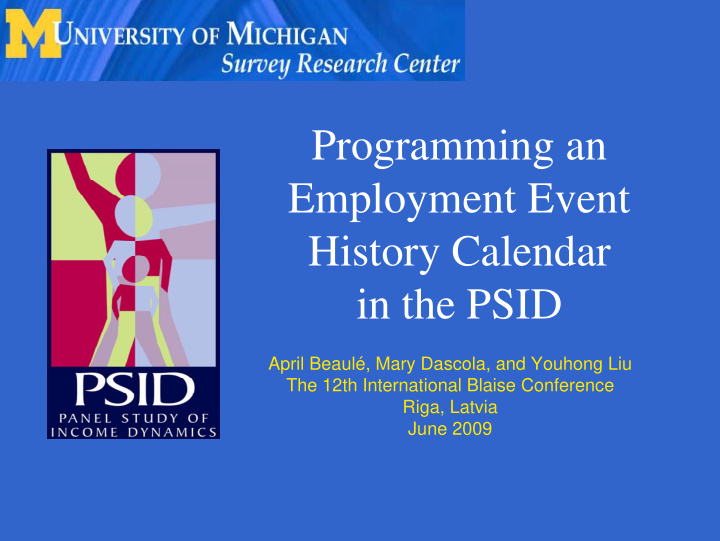



Programming an Employment Event History Calendar in the PSID April Beaulé, Mary Dascola, and Youhong Liu The 12th International Blaise Conference Riga, Latvia June 2009
About the PSID • Nationally representative sample of 8,700 U.S. families • Panel survey conducted since 1968 • Survey instrument programmed in Blaise and C#.net Survey Research Center � Institute for Social Research � University of Michigan
First Experience with EHC • Main survey instrument reprogrammed in Blaise • Early EHC for employment programmed in Visual Basic • Limitations prevented the use of DLLs • Unstructured format of the EHC meant a decline in data integrity Survey Research Center � Institute for Social Research � University of Michigan
Labor Force Participation • Central concept of the PSID • Need to distinguish between types of spells • All 52 weeks • For time spent out of the labor force: – actively looking for employment – periods of not looking Survey Research Center � Institute for Social Research � University of Michigan
Types of Spells- Older Version Survey Research Center � Institute for Social Research � University of Michigan
Goals of the New EHC • Provide visual guide to the interviewer of the domains and how they relate to each other • Provide a combination of hard and soft consistency checks to help resolve inconsistencies on the spot • Write data back to the Blaise bdb to avoid manipulating multiple data sources Survey Research Center � Institute for Social Research � University of Michigan
Employment - New Version Survey Research Center � Institute for Social Research � University of Michigan
Checking for Gaps Survey Research Center � Institute for Social Research � University of Michigan
Incorrect Reporting of Time Away Survey Research Center � Institute for Social Research � University of Michigan
Visual Cues: Start/End Survey Research Center � Institute for Social Research � University of Michigan
Visual Cues: Don’t Know When Survey Research Center � Institute for Social Research � University of Michigan
Cross Check Timelines Survey Research Center � Institute for Social Research � University of Michigan
Programming BLOCK BEmploy Fields AQSN : TAQSN sXML /"Xml string for easy alien router programming":string[2000] sDisplay /"display for summery screen" : string[1000] {part of xXML} sSpanDisplay /"display for summery screen" : string[1000] {part of xXML} sYear /"Start Year " : 1901..9997,DK,EMPTY eYear /"End Year " : 1901..9997,DK,EMPTY sMonthSeason /"Start Month/Season (start month)" : 1..24,DK,EMPTY eMonthSeason /"End Month/Season (End month)" : 1..24,DK,EMPTY sDay / "Start Day (start day of the event)": 1..43,DK,EMPTY eDay / "End Day (End day of the event)": 1..43,DK,EMPTY Employer / "Event Description": string[100],DK,EMPTY Notes / "Event Notes": string[200],DK,EMPTY ENDBLOCK EmploySection : Array [1..10] OF BEmploy Survey Research Center � Institute for Social Research � University of Michigan
Programming Survey Research Center � Institute for Social Research � University of Michigan
Programming CHECK NotWorkNotValid = 0 InVOLVING (BCDE1, EmployEHCRouter.EHCINTRO) "One or more Employment and Not Working lines overlap for more than one cell, please reconcile and correct." Survey Research Center � Institute for Social Research � University of Michigan
Conclusion • EHC superior method for data collection for certain types of retrospective information • Like to take advantage of the flexibility without compromising data integrity • Given the interviewer visual cues, consistency checking and clear warnings about potential conflicts • All the data is stored in bdb for easier processing Survey Research Center � Institute for Social Research � University of Michigan
Thank You April Beaulé abeaule@umich.edu +001 734-936-0073 Mary Dascola mdascola@umich.edu +001 734-936-0308 Youhong Liu yliu@umich.edu +001 734-647-6172
Recommend
More recommend